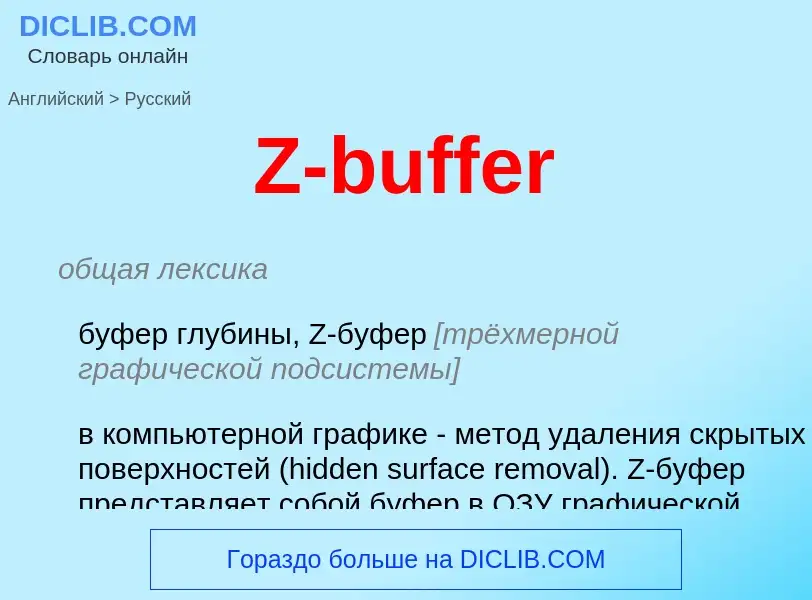Traducción y análisis de palabras por inteligencia artificial ChatGPT
En esta página puede obtener un análisis detallado de una palabra o frase, producido utilizando la mejor tecnología de inteligencia artificial hasta la fecha:
- cómo se usa la palabra
- frecuencia de uso
- se utiliza con más frecuencia en el habla oral o escrita
- opciones de traducción
- ejemplos de uso (varias frases con traducción)
- etimología
Z-buffer - traducción al Inglés
общая лексика
буфер глубины, Z-буфер [трёхмерной графической подсистемы]
в компьютерной графике - метод удаления скрытых поверхностей (hidden surface removal). Z-буфер представляет собой буфер в ОЗУ графической платы для хранения текущих координат глубины (Z-координат) для каждого треугольника выводимого на экран трёхмерного изображения, если они ближайшие к наблюдателю. При отсутствии Z-буфера обсчёт изображений выполняет ЦП, что снижает производительность системы
синоним
Смотрите также
Смотрите также
Definición
Wikipedia
A depth buffer, also known as a z-buffer, is a type of data buffer used in computer graphics to represent depth information of objects in 3D space from a particular perspective. Depth buffers are an aid to rendering a scene to ensure that the correct polygons properly occlude other polygons. Z-buffering was first described in 1974 by Wolfgang Straßer in his PhD thesis on fast algorithms for rendering occluded objects. A similar solution to determining overlapping polygons is the painter's algorithm, which is capable of handling non-opaque scene elements, though at the cost of efficiency and incorrect results.
In a 3D-rendering pipeline, when an object is projected on the screen, the depth (z-value) of a generated fragment in the projected screen image is compared to the value already stored in the buffer (depth test), and replaces it if the new value is closer. It works in tandem with the rasterizer, which computes the colored values. The fragment output by the rasterizer is saved if it is not overlapped by another fragment.
When viewing an image containing partially or fully overlapping opaque objects or surfaces, it is not possible to fully see those objects that are farthest away from the viewer and behind other objects (i.e., some surfaces are hidden behind others). If there were no mechanism for managing overlapping surfaces, surfaces would render on top of each other, not caring if they are meant to be behind other objects. The identification and removal of these surfaces are called the hidden-surface problem. To check for overlap, the computer calculates the z-value of a pixel corresponding to the first object and compares it with the z-value at the same pixel location in the z-buffer. If the calculated z-value is smaller than the z-value already in the z-buffer (i.e., the new pixel is closer), then the current z-value in the z-buffer is replaced with the calculated value. This is repeated for all objects and surfaces in the scene (often in parallel). In the end, the z-buffer will allow correct reproduction of the usual depth perception: a close object hides one further away. This is called z-culling.
The z-buffer has the same internal data structure as an image, namely a 2D-array, with the only difference being that it stores a single value for each screen pixel instead of color images that use 3 values to create color. This makes the z-buffer appear black-and-white because it is not storing color information. The buffer has the same dimensions as the screen buffer for consistency.
Primary visibility tests (such as back-face culling) and secondary visibility tests (such as overlap checks and screen clipping) are usually performed on objects' polygons in order to skip specific polygons that are unnecessary to render. Z-buffer, by comparison, is comparatively expensive, so performing primary and secondary visibility tests relieve the z-buffer of some duty.
The granularity of a z-buffer has a great influence on the scene quality: the traditional 16-bit z-buffer can result in artifacts (called "z-fighting" or stitching) when two objects are very close to each other. A more modern 24-bit or 32-bit z-buffer behaves much better, although the problem cannot be eliminated without additional algorithms. An 8-bit z-buffer is almost never used since it has too little precision.

